非谓语动词语与从句的关系
- 格式:ppt
- 大小:96.00 KB
- 文档页数:23

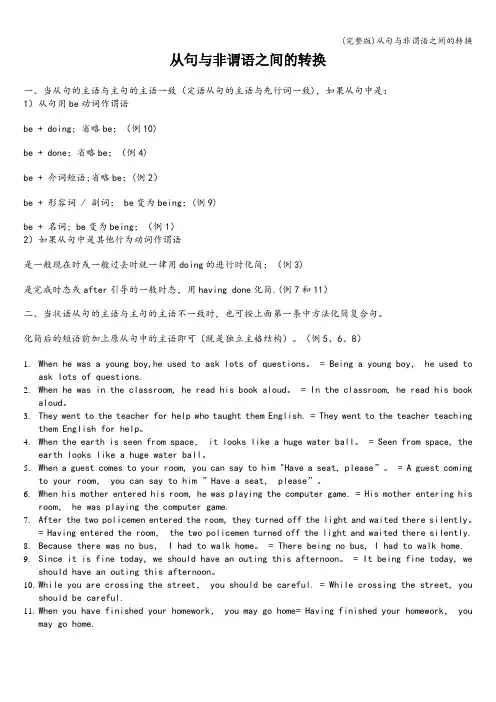
从句与非谓语之间的转换一、当从句的主语与主句的主语一致(定语从句的主语与先行词一致),如果从句中是:1)从句用be动词作谓语be + doing; 省略be;(例10)be + done;省略be;(例4)be + 介词短语;省略be;(例2)be + 形容词 / 副词; be变为being;(例9)be + 名词; be变为being;(例1)2)如果从句中是其他行为动词作谓语是一般现在时或一般过去时就一律用doing的进行时化简;(例3)是完成时态或after引导的一般时态,用having done化简.(例7和11)二、当状语从句的主语与主句的主语不一致时,也可按上面第一条中方法化简复合句。
化简后的短语前加上原从句中的主语即可(既是独立主格结构)。
(例5、6、8)1.When he was a young boy,he used to ask lots of questions。
= Being a young boy, he used toask lots of questions.2.When he was in the classroom, he read his book aloud。
= In the classroom, he read his bookaloud。
3.They went to the teacher for help who taught them English. = They went to the teacher teachingthem English for help。
4.When the earth is seen from space, it looks like a huge water ball。
= Seen from space, theearth looks like a huge water ball。
5.When a guest comes to your room, you can say to him "H ave a seat, please”。
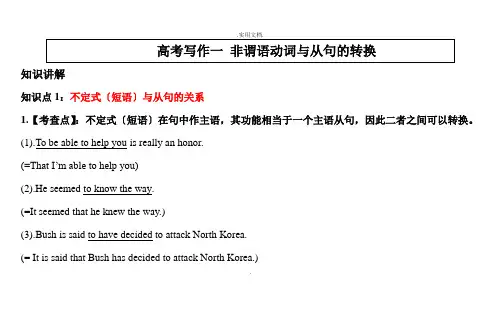
知识讲解知识点1:不定式〔短语〕与从句的关系1.【考查点】:不定式〔短语〕在句中作主语,其功能相当于一个主语从句,因此二者之间可以转换。
(1).To be able to help you is really an honor.(=That I’m able to help you)(2).He seemed to know the way.(=It seemed that he knew the way.)(3).Bush is said to have decided to attack North Korea.(= It is said that Bush has decided to attack North Korea.)..2.【考查点】:不定式〔短语〕在句中作宾语或宾补,相当于一个宾语从句(1).We still don’t know when and where to build a school.(宾语)(=when and where we should build a school)(2).I advised him to go and see the doctor.(宾补)(=that he should go and see)(3).He thought it a great pity not to have invited her. .(宾语)(=That he hadn’t invited her.).3.【考查点】:不定式〔短语〕在句中作表语.,相当于一个表语从句(1).My suggestion is for them to leave as soon as possible.(=that they should leave)(2).My chief purpose has been for them to get a good understanding. (=that they can get a good understanding).4.【考查点】:不定式〔短语〕在句中作定语.,相当于一个定语从句(1).The question will be discussed at the conference shortly to open in Beijing. (=that is shortly to open in Beijing)(2).All dead, I was the only one to grow up.(=that grew up).5.【考查点】:不定式〔短语〕在句中作目的.结果状语.,相当于一个目的.结果状语从句(1).He came to the area in order/so as to study the folk music there.(=in order/so that)(2).The lady was so excited as not to say a word.(=so excited that she couldn’t…).6.【考查点】:不定式〔短语〕在句中作原因状语.,相当于一个原因状语从句(1).I trembled to think of being punished by the boss.(=because I though of being punished by the boss)(2).We were disappointed to have lost the game.(=that we have lost the game).知识点2:动名词〔短语〕与从句的关系1.【考查点】:动名词〔短语〕在句中作主语,相当于一个主语从句(1).Your going away (=That you went away) made the professor angry.(2).Mary’s not being made monitor (=That Mary was not made monitor ) made us sad. 被动的动名词在句中作主语时一般不能省(3).Being called a fool(=That he was called a fool) hurt Bob badly..2.【考查点】:动名词〔短语〕再句中作宾语或宾补语,相当于一个宾语从句(1).I remember being taken to Beijing(=that I was taken to Beijing) when I was five.(2).He admitted having married Mary to a soldier(=that he had married Mary to a soldier)..3.【考查点】:动名词〔短语〕在句中作表语.,相当于一个表语从句(1).My duty is serving the people heart and soul.=(that I’ll serve the people heart and soul).(2).The problem is his not having prepared his lessons for the exam.=〔that he hasn’t prepared his lessons fo r the exam〕.(3).The difficulty is Mary’s being caught between the two trees.=〔that Mary is caught between the two trees〕..4.【考查点】:介词+动名词〔短语〕,相当于一个从句(1).He was afraid of being scolded by his mistake.(=that he was…)(2).He was astonished at her knowing you.(=that she knew you)(3).We heard the news of our team having won.(=that our team had won).知识点3:分词〔短语〕与从句的关系1.【考查点】:分词〔短语〕作定语,相当于一个定语从句(1).The hospital was an old building built in 1931(=that was built in 1931).(2).Do you know the girl standing over there(=who is standing over there)?(3).The man speaking to us the other day(= who spoke to us the other day) has gone to Japan..2.【考查点】:分词独立结构,相当于一个状语从句,其中伴随状语多与并列句转换(1).Weather permitting, we’ll have the match tomorrow.(=If weather permits)(2).The dark clouds having disappeared, the sun shone again.(=When the dark clouds had disappeared)(3).The monitor being ill we’d better put the meting off.(=As the monitor was ill)(4).Other things being equal(=If other things are equal), I’d b uy the black dress.(5).Given more time(=If we were given more time), we could have done it better.(6).He came back, his hands tied to his back(=his hands were tied to his back)..3.【考查点】:分词短语,相当于一个状语从句(1).On arriving(=As soon as I arrive) there, I’ll te lephone you.〔时间〕(2).(While)waiting(=While I was waiting )for the bus, I caught sight of her.〔时间〕(3).Educated(=As he was educated ) by the party, he became a great fighter.〔原因〕(4).Not having received(=Because I hadn’t received an answer, I wrote to him again.〔原因〕(5).(If) given(=If we had been given )enough time, e could have done it better.〔条件〕(6).(Though) having made(=Though he had made) great achievements, he didn’t pride.(让步).4.【考查点】:分词短语作状语,可表伴随,结果,相当于and 的并列句,也可和with 转换(1).He died, leaving his daughter much money.(=and left)(2).The teacher entered the lab, followed by our students.(=and he was followed by our students =with us following him=and we followed him).5.【考查点】:分词短语在句中作宾语或宾语补足语,相当于一个宾语从句(1).He found the windows broken.(=He found that the windows were broken.)(2).I felt my heart beating fast at the news of bomb explosion.(=I felt that my heart was besting fast at the news of bomb explosion).知识点4:特殊转换1.【考查点】:动名词复合结构相当于从句(1).Sophia’s having seen them(=That Sophia had seen them) didn’t surprised us.(2).I can’t bear his (him) staying up so late(=that he stays up so late).(3).We encourage students’ living in the school(=that students live in the school).(4).What was disappointing was our not being able to go for a picnic (that we were not able to go for a picnic)..2.【考查点】:there+being+其他成分(1).There being nothing to do, we played games.(=Because there was nothing to do) (原因)(2).They closed the store, there being no customers.(=Because ther was no customers) (原因).四、例题精析【例题1】Everyone in our class was working hard and doing what we could _______ a good college.A. enterB. to enterC. enteringD. entered【答案】B【解析】容易误选A。
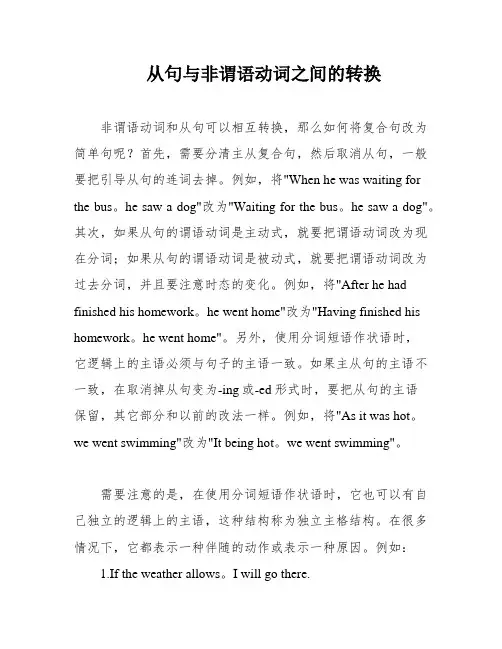
从句与非谓语动词之间的转换非谓语动词和从句可以相互转换,那么如何将复合句改为简单句呢?首先,需要分清主从复合句,然后取消从句,一般要把引导从句的连词去掉。
例如,将"When he was waiting for the bus。
he saw a dog"改为"Waiting for the bus。
he saw a dog"。
其次,如果从句的谓语动词是主动式,就要把谓语动词改为现在分词;如果从句的谓语动词是被动式,就要把谓语动词改为过去分词,并且要注意时态的变化。
例如,将"After he had finished his homework。
he went home"改为"Having finished his homework。
he went home"。
另外,使用分词短语作状语时,它逻辑上的主语必须与句子的主语一致。
如果主从句的主语不一致,在取消掉从句变为-ing或-ed形式时,要把从句的主语保留,其它部分和以前的改法一样。
例如,将"As it was hot。
we went swimming"改为"It being hot。
we went swimming"。
需要注意的是,在使用分词短语作状语时,它也可以有自己独立的逻辑上的主语,这种结构称为独立主格结构。
在很多情况下,它都表示一种伴随的动作或表示一种原因。
例如:1.If the weather allows。
I will go there.2.After the rain ped。
XXX.3.His XXX。
and he prepared to return to his institute.4.With so many comrades absent。
XXX.From the above examples。
we can see that the present participle (-ing) usually indicates an n that is happening at the same time as the main verb in the sentence。
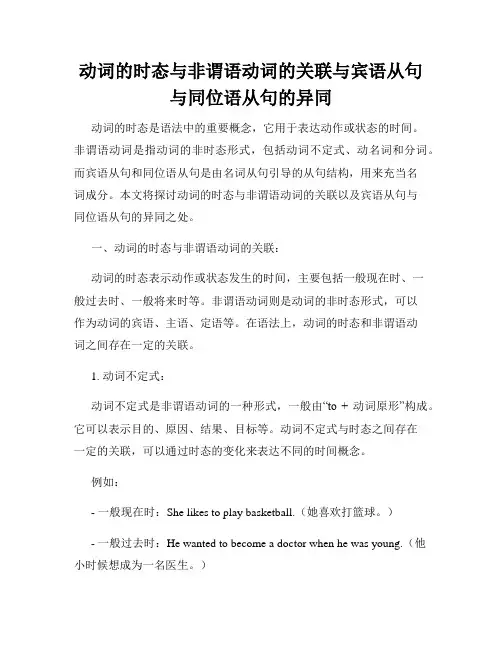
动词的时态与非谓语动词的关联与宾语从句与同位语从句的异同动词的时态是语法中的重要概念,它用于表达动作或状态的时间。
非谓语动词是指动词的非时态形式,包括动词不定式、动名词和分词。
而宾语从句和同位语从句是由名词从句引导的从句结构,用来充当名词成分。
本文将探讨动词的时态与非谓语动词的关联以及宾语从句与同位语从句的异同之处。
一、动词的时态与非谓语动词的关联:动词的时态表示动作或状态发生的时间,主要包括一般现在时、一般过去时、一般将来时等。
非谓语动词则是动词的非时态形式,可以作为动词的宾语、主语、定语等。
在语法上,动词的时态和非谓语动词之间存在一定的关联。
1. 动词不定式:动词不定式是非谓语动词的一种形式,一般由“to + 动词原形”构成。
它可以表示目的、原因、结果、目标等。
动词不定式与时态之间存在一定的关联,可以通过时态的变化来表达不同的时间概念。
例如:- 一般现在时:She likes to play basketball.(她喜欢打篮球。
)- 一般过去时:He wanted to become a doctor when he was young.(他小时候想成为一名医生。
)- 一般将来时:They are going to visit their grandparents next week.(下周他们打算去看望他们的祖父母。
)2. 动名词:动名词是非谓语动词的一种形式,一般由动词的-ing形式构成。
它可以作为主语、宾语、表语或定语等。
与动词的时态关联,动名词通常没有明确的时态概念,而是通过上下文来确定动作发生的时间。
例如:- 一般现在时:Listening to music helps me relax.(听音乐帮助我放松。
)- 一般过去时:I enjoyed playing football when I was a child.(小时候我喜欢踢足球。
)- 一般将来时:She is considering going abroad for further study.(她正在考虑出国深造。
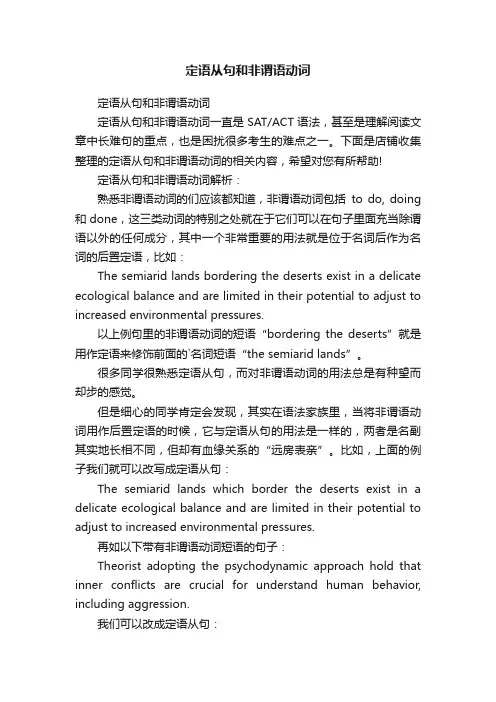
定语从句和非谓语动词定语从句和非谓语动词定语从句和非谓语动词一直是SAT/ACT语法,甚至是理解阅读文章中长难句的重点,也是困扰很多考生的难点之一。
下面是店铺收集整理的定语从句和非谓语动词的相关内容,希望对您有所帮助!定语从句和非谓语动词解析:熟悉非谓语动词的们应该都知道,非谓语动词包括to do, doing 和done,这三类动词的特别之处就在于它们可以在句子里面充当除谓语以外的任何成分,其中一个非常重要的用法就是位于名词后作为名词的后置定语,比如:The semiarid lands bordering the deserts exist in a delicate ecological balance and are limited in their potential to adjust to increased environmental pressures.以上例句里的非谓语动词的短语“bordering the deserts”就是用作定语来修饰前面的`名词短语“the semiarid lands”。
很多同学很熟悉定语从句,而对非谓语动词的用法总是有种望而却步的感觉。
但是细心的同学肯定会发现,其实在语法家族里,当将非谓语动词用作后置定语的时候,它与定语从句的用法是一样的,两者是名副其实地长相不同,但却有血缘关系的“远房表亲”。
比如,上面的例子我们就可以改写成定语从句:The semiarid lands which border the deserts exist in a delicate ecological balance and are limited in their potential to adjust to increased environmental pressures.再如以下带有非谓语动词短语的句子:Theorist adopting the psychodynamic approach hold that inner conflicts are crucial for understand human behavior, including aggression.我们可以改成定语从句:Theorist who adopt the psychodynamic approach hold that inner conflicts are crucial for understand human behavior, including aggression.又如,以下的两个句子的意思是相同的:1.What audience came to see was the magic made possible by trick photography and manipulation of the cinema.2.What audience came to see was the magic that was made possible by trick photography and manipulation of the cinema.在很多情况下,学生更容易理解定语从句。
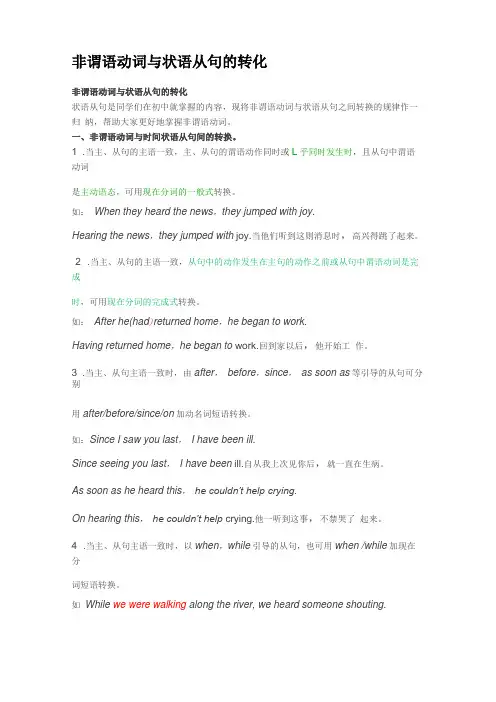
非谓语动词与状语从句的转化非谓语动词与状语从句的转化状语从句是同学们在初中就掌握的内容,现将非谓语动词与状语从句之间转换的规律作一归纳,帮助大家更好地掌握非谓语动词。
一、非谓语动词与时间状语从句间的转换。
1 .当主、从句的主语一致,主、从句的谓语动作同时或L乎同时发生时,且从句中谓语动词是主动语态,可用现在分词的一般式转换。
如:When they heard the news,they jumped with joy.Hearing the news,they jumped with joy.当他们听到这则消息时,高兴得跳了起来。
2 .当主、从句的主语一致,从句中的动作发生在主句的动作之前或从句中谓语动词是完成时,可用现在分词的完成式转换。
如:After he(had)returned home,he began to work.Having returned home,he began to work.回到家以后,他开始工作。
3 .当主、从句主语一致时,由after,before,since,as soon as等引导的从句可分别用after/before/since/on加动名词短语转换。
如:Since I saw you last,I have been ill.Since seeing you last,I have been ill.自从我上次见你后,就一直在生病。
As soon as he heard this,he couldn’t help crying.On hearing this,he couldn’t help crying.他一听到这事,不禁哭了起来。
4 .当主、从句主语一致时,以when,while引导的从句,也可用when /while加现在分词短语转换。
如While we were walking along the river, we heard someone shouting.While walking along the river,we heard someone shouting当我们正沿着河走时,我们听到有人喊叫。


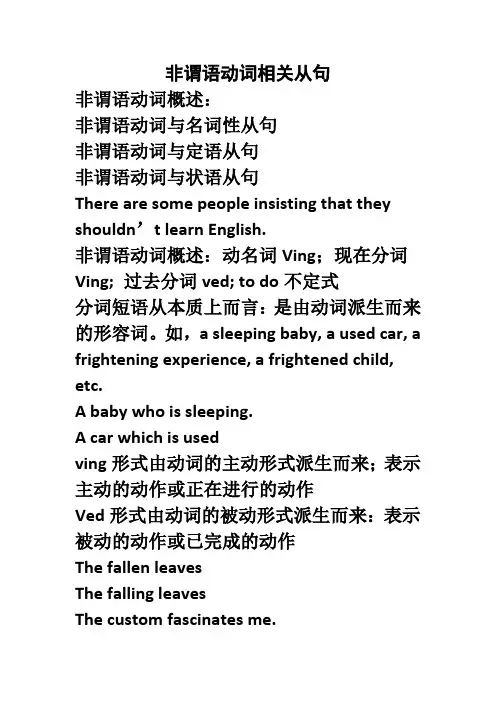
非谓语动词相关从句非谓语动词概述:非谓语动词与名词性从句非谓语动词与定语从句非谓语动词与状语从句There are some people insisting that they shouldn’t learn English.非谓语动词概述:动名词Ving;现在分词Ving; 过去分词ved; to do不定式分词短语从本质上而言:是由动词派生而来的形容词。
如,a sleeping baby, a used car, a frightening experience, a frightened child, etc.A baby who is sleeping.A car which is usedving形式由动词的主动形式派生而来;表示主动的动作或正在进行的动作Ved形式由动词的被动形式派生而来:表示被动的动作或已完成的动作The fallen leavesThe falling leavesThe custom fascinates me.The fascinating custom has been the subject of many books.The baby will sleep until eight.Try not to wake a sleeping baby.Some movies are rated X.Children shouldn’t see X-rated movies. My leg was broken in three places.My broken leg is healing slowly.The sinking ship= the ship that was sinking The sunken ship=the ship that has sunken. Falling leaves=Fallen leaves=现在分词的完成时态:表示分词的动作发生在主句谓语动词动作之前。
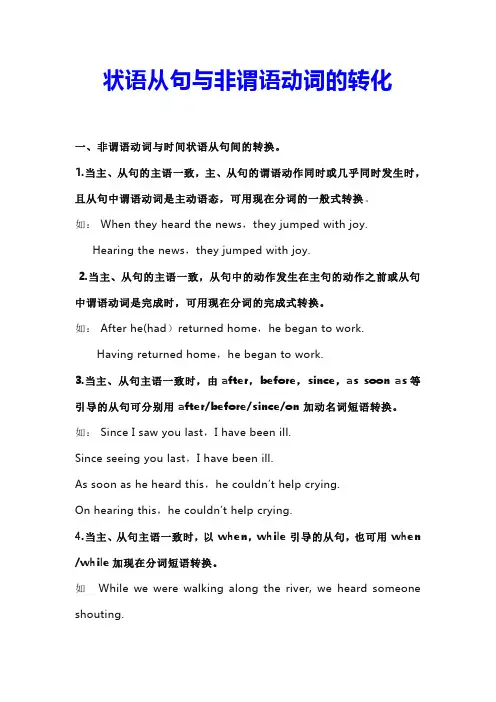
状语从句与非谓语动词的转化一、非谓语动词与时间状语从句间的转换。
1.当主、从句的主语一致,主、从句的谓语动作同时或几乎同时发生时,且从句中谓语动词是主动语态,可用现在分词的一般式转换。
如: When they heard the news,they jumped with joy.Hearing the news,they jumped with joy.2.当主、从句的主语一致,从句中的动作发生在主句的动作之前或从句中谓语动词是完成时,可用现在分词的完成式转换。
如: After he(had)returned home,he began to work.Having returned home,he began to work.3.当主、从句主语一致时,由after,before,since,as soon as等引导的从句可分别用after/before/since/on加动名词短语转换。
如: Since I saw you last,I have been ill.Since seeing you last,I have been ill.As soon as he heard this,he couldn’t help crying.On hearing this,he couldn’t help crying.4.当主、从句主语一致时,以when,while引导的从句,也可用when /while加现在分词短语转换。
如While we were walking along the river, we heard someone shouting.While walking along the river,we heard some one shouting.5.当主、从句的主语一致,且从句的谓语动词是被动语态时,可用过去分词短语转换。
如:After they were sent to the zoo, the monkeys had good health. Sent to the zoo, the monkeys had good health.6.当主、从句的主语不一致时,时间状语从句可转换成分词的独立主格结构,即名词/主格代词+分词。
非谓语动词非谓语动词(不能作谓语用)包括不定式、分词及动名词。
一、动词不定式1.常用形式:一般主动式to do, 一般被动式to be done完成主动式to have done, 完成被动式to have been done进行式to be doing不定式的时态形式所表示的时间关系:1)一般式:表示的动作和谓语动词所表示的动作同时发生,或在谓语动作之后,或没有时间限制。
例如:They often watch us play table tennis.(与谓语动作同时)She hopes to go there again.(在谓语动作之后)It is necessary and important to read English every day.(无时间限制)The factory to make radios is over there.(无时间限制)m sorry to have kept you waiting.2)完成式:表示的动作在谓语动词所表示的动作之前。
如:I /She seems to have been a teacher for many years.3)进行式:表示正在发生的动作且与谓语动作同时发生。
例如:She happened to be writing a letter in the room when I come in.注:不定式的被动式:名词、代词为不定式的逻辑宾语时,一般用不定式被动式,例如:What is to be done is unknown. /The bridge to be bulit there is very long.不定式的否定式 not to do2.语法功能:可作主语、表语、宾语、宾补、定语和状语(即除谓语之外的各种成分)。
例如:1)主语:To master a foreign language is very important.2)表语:My job is to drive them to the company every day.3)宾语:Do you want to visit the Great Wall?Can you give us some advice on what to do next?4)宾补:The teacher advised us to have a rest first.I didn’t notice them come in.注:see, hear, watch, notice, have, make, let等动词后作宾补的动词不定式不带to, 但变为被动语态以后(即不定式作主补时)要带to,其中let sb. do sth. 变为被动式为sb. is let do sth. help(帮助)后作宾补的动词不定式可带to,也可不带to. 即help sb.(to)do sth.5)不定式作定语:作后置定语,位于被修饰词后如:Who was the first one to get to the top of the hill yesterday?He is the man to depend on/to believe in.不定式作定语,与被其修饰的词可构成逻辑上的以下关系:a.动宾关系 e.g. I have a lot of work to do.b.主谓关系 e.g. He is always the first to help me.c.其它关系(多为固定搭配) e.g. tell me a way to solve the problem.6)状语: in order toA.目的状语:She reads China Daily every day so as to improve her English.to注:in order to 可以位于句首或句中,so as to 不能位于句首。
非谓语作定语和定语从句的区别
非谓语动词作定语和定语从句在语法结构和表达方式上有一些区别,具体如下:
1. 语法结构:
- 非谓语动词作定语:非谓语动词包括动词的现在分词(-ing)、过去分词(-ed)和不定式(to do),它们可以在句中作定语,修饰名词或代词。
非谓语动词作定语时,通常放在被修饰词的前面。
- 定语从句:定语从句是一个句子,由关系代词(who, whom, whose, that, which)引导,用来修饰先行词(即被修饰的名词或代词)。
2. 表达方式:
- 非谓语动词作定语:非谓语动词作定语可以提供更简洁、紧凑的表达方式。
它可以通过一个动词形式来描述被修饰词的特征、状态或行为。
- 定语从句:定语从句可以提供更详细、具体的信息,通过一个完整的句子来描述被修饰词的性质、特点或关系。
3. 语义和功能:
- 非谓语动词作定语:非谓语动词作定语主要强调动作或状态,它们可以表示正在进行的动作(-ing 形式)、已完成的动作(-ed 形式)或将要进行的动作(to do 形式)。
- 定语从句:定语从句可以提供更丰富的语义信息,包括对被修饰词的进一步解释、限定或描述。
总的来说,非谓语动词作定语和定语从句在语法结构和表达方式上有所不同。
非谓语动词作定语更简洁,强调动作或状态;而定语从句更详细,提供更多的语义信息。
在使用时,需要根据具体语境和表达需要选择合适的结构。
非谓语从句和定语从句非谓语从句和定语从句导语:关系代词所代替的先行词是人或物的名词或代词,并在句中充当主语、宾语、定语等成分。
关系代词在定语从句中作主语时,从句谓语动词的人称和数要和先行词保持一致。
以下店铺为大家介绍非谓语从句和定语从句文章,欢迎大家阅读参考!非谓语从句和定语从句非谓语从句中的非是整个当中非常重要的部分,也是学生的一个难点。
其实,我们可以从从句的角度来解释非,弄清非谓语动词与从句的关系,这样会使学生对非谓语动词有更好的了解,学习起来更容易。
I. v-ing 形式与从句之间的转换1. v-ing形式作主语可换成that引导的主语从句Tom's knowing English helps him in learning French. That Tom knows English helps him in learning English.Her being out of work was unexpected. That she was out of work was unexpected.2. v-ing形式作宾语或宾补可换成that引导的宾语从句I remember having paid him for his work. I remember that I have paid him for his work.He suggests our making better use of the school library. He suggests that we (should) make better use of the school library.3. v-ing形式作表语可换成that引导的表语从句Our worry is your depending too much on him. Our worry is that you depend too much on him.The question is many people's being trapped in the fire. The question is that many people are trapped in the fire.4. v-ing形式作定语可换成that, who, which引导的定语从句We will study in the house facing south. We will study in thehouse that / which faces south.The man talking to my teacher is my father. The man who / that is talking to my teacher is my father.5. v-ing形式作状语可换成相应状语从句On arriving there, I will telephone you. As soon as I arrive there, I will telephone you.While waiting for the bus, I caught sight of her. While I was waiting for the bus, I caught sight of her.另外,v-ing形式在句中表伴随或作结果状语,相当于一个并列句,也可和with结构转换。
定语从句和非谓语动词是高中阶段重要的两大语法项目。
定语从句的应用可以使语言表达更精确更生动,显得使用者具有较高的英语文化底蕴,但也是中学英语的难点语法项目,许多同学在学习和运用定语从句时,感到很难理解。
若将其简化,理解起来就比较简单了。
而非谓语动词的正确使用,就可以使定语从句的理解容易化,简单化,而且使语句简练、更有文采。
掌握二者的转换,有助于我们更好的理解其用法,并能够自如地运用。
下面我就着重谈谈如何将定语从句转换成非谓语动词以及转换时应注意的事项。
1定语从句转换成不定式“to do”。
定语从句的谓语动词是将来时或含有情态动词或含有序数词the next, the last等时,该定语从句转换为不定式“to do”.(1)The plane which will arrive is from Hubei.(2)The students will go to a party that will be held in our class at 7:45.(3)He was the first boy who came to school..2定语从句可转换成为“介词+关系代词或副词+不定式”。
“介词+关系代词”引导的定语从句和“介词+关系代词或副词+不定式”充当的定语,可以相互转换。
被这种定语修饰的名词往往在逻辑上充当不定式动作的地点、时间或工具。
例:(1)She wanted a room in which she could do her homework.(2)She had only a pen with which she can write.注:定语从句转换成“介词+ 关系代词+不定式”时,此时的不定式一定是及物动词,如是不及物动词,则需在动词后面加上相应的介词。
这个介词可提前到关系代词前面,也可留在句尾。
前者是正式说法后者是非正式说法。
而且上例中动词不定式与句子主语之间存在着逻辑上的主谓关系,否则就不能简单地把作定语的不定式都变成此结构。